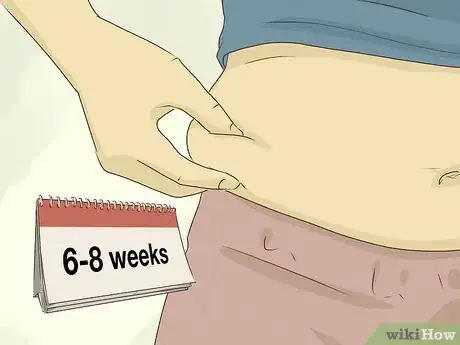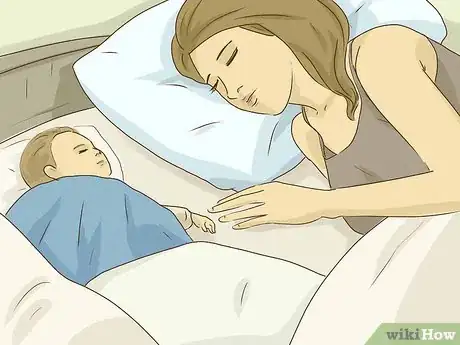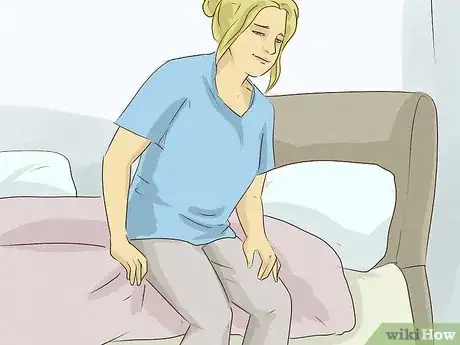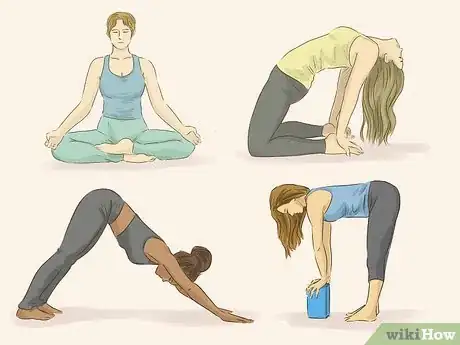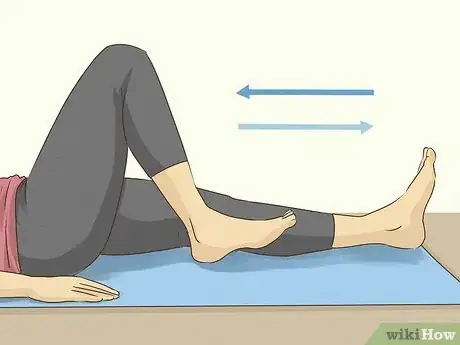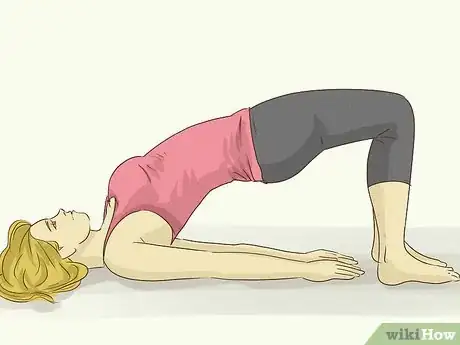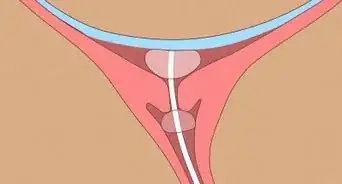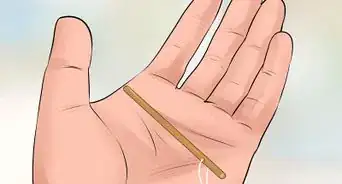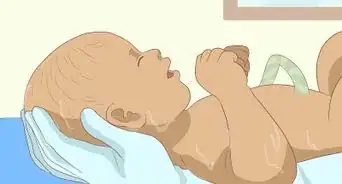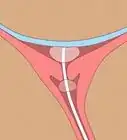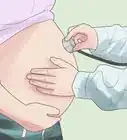This article was co-authored by Shira Tsvi and by wikiHow staff writer, Amy Bobinger. Shira Tsvi is a Personal Trainer and Fitness Instructor with over 7 years of personal training experience and over 2 years leading a group training department. Shira is certified by the National College of Exercise Professionals and the Orde Wingate Institute for Physical Education and Sports in Israel. Her practice is based in the San Francisco Bay Area.
There are 11 references cited in this article, which can be found at the bottom of the page.
This article has been viewed 46,920 times.
Having a baby is a life-changing experience, but it's normal if you feel a little self-conscious about the changes to your body after your baby is born. While you might want to get back to your pre-pregnancy shape as soon as possible, the most important thing you can do for your body is to give it plenty of time to recover, especially if you had a C-section. However, you can reduce your belly over time if you focus on your nutrition and overall well-being as you heal, and add in core-strengthening exercises a little at a time as your doctor okays it.
Steps
Living a Healthy Lifestyle
-
1Don't push yourself to lose your belly too soon. It takes 6-8 weeks for your uterus to return back to its normal size after you give birth.[1] During that time, you may still have a little bit of a baby belly, even if you don't have much body fat. Give yourself time for your body to recover, and remember that it's important to work with your doctor and listen to your own body, so don't just assume that what worked for someone else will work for you.
- Even if you see celebrities who seem to bounce back within just a few weeks of giving birth, don't get discouraged. Remind yourself that they likely have a team of trainers and nutritionists assisting them, and they might even use unhealthy methods in order to look a certain way.
-
2Eat a healthy, well-rounded diet. To ensure your body has the fuel it needs to recover while still giving you the energy you need to care for your new baby, choose meals that are rich in lean proteins, whole grains, fruits, and veggies.[2] At the same time, avoid foods that are full of sugars, processed carbs, and saturated fats.[3]
- For instance, for lunch you might have a grilled chicken sandwich on whole wheat toast, topped with veggies like red peppers, spinach, and avocados.
- The only way to really reduce the size of your belly is to burn more calories than you take in, so it's especially important that you pay attention to the foods you're eating while you're recovering from your C-section and your activity level is restricted.
- Breastfeeding may help you lose weight after your baby is born, but don't restrict your calories if you're nursing. You'll need to eat at about 1800 calories a day to ensure your body can keep up with the demands of milk production.
Advertisement -
3Drink plenty of water.[4] An adult woman should typically drink about 11.5 cups (2,700 ml) of water a day,[5] and you'll need even more than that if you're breastfeeding. In addition to keeping your body hydrated, drinking plenty of water each day will help your body burn fat and flush away excess fluids, which may help your belly look smaller with time.[6]
- Usually, if you just drink a glass of water any time you feel thirsty, you'll stay hydrated.
-
4Sleep when your baby sleeps. It can seem impossible to accomplish with a new baby, but getting enough sleep has a ton of benefits for your physical and mental health. Even if you can't get an uninterrupted night's sleep right away, try taking a nap whenever your baby does. That can help you make up the difference until they start to establish a more regular day-night sleep cycle, which typically occurs when your baby is about 1-3 months old.[7]
- In addition to helping you cope with the challenges of caring for a newborn, getting enough sleep will give your body more time to heal from your C-section, and it might even help you achieve your overall weight loss goals sooner.[8]
Getting Active During Recovery
-
1Talk to your doctor before doing any new exercises. When you're recovering from a C-section, your doctor will give you post-operative care instructions. It's essential that you follow these directions to ensure your body heals completely. Don't rush into exercise sooner than your doctor recommends, and call and ask your doctor if you're not sure if a new activity would be too strenuous.[9]
- During the first few weeks, you shouldn't lift anything harder than your baby, and you'll need to avoid any activities that require you to stretch, lift, or bend. It can take 6-10 weeks for your C-section incision to heal completely.[10]
Did You Know? You can't spot-reduce fat from any areas of your body, so exercise alone won't make your belly look toned. Instead, you have to lose weight from your whole body to reveal the muscles underneath that surface layer of fat—at which point you can use toning exercises to help those muscles look more defined.
-
2Get moving as soon as you can. While you shouldn't do anything that will put pressure or tension on your C-section site, you should still try to add in light activity as soon as you're able to handle it. As the weeks pass and your body heals, look for new ways to get up and move around, which can help your body burn calories until you're able to get back to exercising again.[11]
- In the first few days after you give birth, for instance, you might stand up or walk for short periods at a time, if your care team recommends it.
-
3Walk for a low-impact way to get exercise. While you may not be able to hit the gym right away, you may feel up to taking short walks within a few weeks of having a C-section. If your doctor says it's okay, taking a walk on a level surface, like a sidewalk or a paved trail, is a great way to burn calories until you're cleared for more strenuous exercise. As a bonus, if you're walking outside, the fresh air can help boost your mood![12]
- Avoid walking on uneven terrain until you're completely healed, since that might strain your incision site.
-
4Add in yoga after 6-8 weeks to strengthen and tone your core. When your doctor gives you permission to start adding in more activity, consider using yoga to help restore your flexibility while strengthening your core. In addition, yoga is an excellent stress reliever, so it can also help you cope with the challenges of being a new mom.[13]
- If you're new to yoga, take a beginner's yoga class to ensure you learn the proper form for each pose. However, even if you practiced yoga before or during your pregnancy, keep in mind it's still important to start slowly to help your body re-acclimate to the poses.
-
5Tighten your abs gently with lower abdominal slides. About 4-6 weeks after your C-section, you may be able to add in leg slides, if your incision is healing normally and your doctor agrees. To do this exercise, lie on your back when your knees bent and your feet flat on the floor. Tighten your core, then inhale and slide one leg out in front of you as far as you can without lifting your back. Then, exhale as you bend your knee and bring your leg back to the starting point.[14]
- Work up to doing this about 20 times on each side.
-
6Try bridges to strengthen your glutes and abs at the same time. To do a bridge, lie on an exercise mat with your feet flat on the floor and your arms at your side, palms-down. Then, push up with your feet until your body makes a straight line from your shoulders all the way down to your knees. Hold that for a few seconds, then ease back down.[15]
- Try to work up to doing 2 sets of 10 bridges each, holding each bridge for about 5 seconds.
- While bridges are commonly considered an exercise just to work on your glutes, they can also be a great way to gently tone your abdominal muscles after a C-section.[16]
-
7Do planks to stabilize your core once you're fully cleared for exercise. To do a plank, lay face-down on an exercise mat, then place your hands beneath your shoulders and push yourself up until your arms are straight. As you do so, lift up onto your toes, and imagine forming a perfectly straight line from your head all the way to your toes.[17]
- When you're starting out, try to hold your plank for about 5 breaths. Then, gradually work up from there.
- During your plank, keep your head up and squeeze your glutes while keeping your shoulder blades as wide as you can.[18]
Warnings
- Always talk to your doctor before trying any new exercises, especially while you're recovering from a surgical procedure like a C-section.⧼thumbs_response⧽
References
- ↑ https://www.marchofdimes.org/pregnancy/your-body-after-baby-the-first-6-weeks.aspx#
- ↑ Shira Tsvi. Personal Trainer & Fitness Instructor. Expert Interview. 7 January 2020.
- ↑ https://parenting.firstcry.com/articles/how-to-reduce-tummy-after-cesarean-delivery-exercises-tips-and-more/
- ↑ Shira Tsvi. Personal Trainer & Fitness Instructor. Expert Interview. 7 January 2020.
- ↑ https://www.mayoclinic.org/healthy-lifestyle/nutrition-and-healthy-eating/in-depth/water/art-20044256
- ↑ https://parenting.firstcry.com/articles/how-to-reduce-tummy-after-cesarean-delivery-exercises-tips-and-more/
- ↑ https://kidshealth.org/en/parents/sleep13m.html
- ↑ https://www.mayoclinic.org/healthy-lifestyle/nutrition-and-healthy-eating/in-depth/water/art-20044256
- ↑ https://www.mayoclinic.org/healthy-lifestyle/labor-and-delivery/in-depth/c-section-recovery/art-20047310
- ↑ https://raisingchildren.net.au/pregnancy/labour-birth/recovery-after-birth/after-caesarean
- ↑ https://www.hellomotherhood.com/article/456452-how-to-get-rid-of-the-belly-bulge-after-a-c-section/
- ↑ https://parenting.firstcry.com/articles/how-to-reduce-tummy-after-cesarean-delivery-exercises-tips-and-more/
- ↑ https://parenting.firstcry.com/articles/how-to-reduce-tummy-after-cesarean-delivery-exercises-tips-and-more/
- ↑ https://www.healthywomen.org/content/ask-expert/1623/postpartum-exercises-when-and-how-start
- ↑ https://www.coachmag.co.uk/glute-exercises/2333/glute-bridge-how-to-do-it-benefits-and-variations
- ↑ https://parenting.firstcry.com/articles/how-to-reduce-tummy-after-cesarean-delivery-exercises-tips-and-more/
- ↑ https://parenting.firstcry.com/articles/how-to-reduce-tummy-after-cesarean-delivery-exercises-tips-and-more/
- ↑ https://www.realsimple.com/health/fitness-exercise/how-to-do-a-plank
